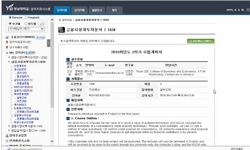본 연구에서는 국내에서 소비되는 일부 상용식품의 비타민 K₁ 함량을 측정하고자 하였으며, 이 분석방법을 검증하며 결과의 신뢰도를 확보하고자 하였다. 각 식품군의 비타민 K는 용매추출...
http://chineseinput.net/에서 pinyin(병음)방식으로 중국어를 변환할 수 있습니다.
변환된 중국어를 복사하여 사용하시면 됩니다.
- 中文 을 입력하시려면 zhongwen을 입력하시고 space를누르시면됩니다.
- 北京 을 입력하시려면 beijing을 입력하시고 space를 누르시면 됩니다.
https://www.riss.kr/link?id=A100751538
- 저자
- 발행기관
- 학술지명
- 권호사항
-
발행연도
2015
-
작성언어
Korean
- 주제어
-
등재정보
KCI등재,SCOPUS
-
자료형태
학술저널
- 발행기관 URL
-
수록면
1194-1199(6쪽)
-
KCI 피인용횟수
1
- 제공처
-
0
상세조회 -
0
다운로드
부가정보
국문 초록 (Abstract)
본 연구에서는 국내에서 소비되는 일부 상용식품의 비타민 K₁ 함량을 측정하고자 하였으며, 이 분석방법을 검증하며 결과의 신뢰도를 확보하고자 하였다. 각 식품군의 비타민 K는 용매추출법을 이용하여 추출하였으며, 포스트칼럼이 장착된 역상 HPLC를 통하여 분리, 정량하였다. 채소류에서는 고구마 잎이 1,467.3 μg/100 g으로 가장 높았으며, 과일류는 녹색 키위가 42.7 μg/100 g으로 가장 높게 분석되었다. 두류에서는 녹두가 63.4 μg/100 g으로 가장 높은 값을 나타내었다. 분석방법을 검증하기 위하여 직선성, 재현성, 반복성, 회수율 및 peak purity를 구하였으며 분석관리 차트를 작성하여 분석 결과 값을 관리하였다. 그 결과 본 시험법에서 표준물질의 피크 머무름시간과 모시잎 시료의 피크 머무름시간이 일치하여 특이성을 확인하였다. 검량선의 상관계수는 0.9999 이상으로 높은 유의 수준을 보여 분석에 적합함을 알 수 있었으며, 반복성과 재현성의 변동계수는 각각 2.33, 3.93%로 나타났고 회수율은 103.67%로 우수하게 나타났다. 본 연구에서 분석된 자료는 표준화된 식품성분표의 기초 자료로 이용될 수 있을 것으로 판단된다.
다국어 초록 (Multilingual Abstract)
Vitamin K1 (phylloquinone) content of commonly consumed foods in Korea were determined by solvent extraction followed by reversed-phase liquid chromatography using post-column derivatization and fluorescence detection. Samples were obtained in the yea...
Vitamin K1 (phylloquinone) content of commonly consumed foods in Korea were determined by solvent extraction followed by reversed-phase liquid chromatography using post-column derivatization and fluorescence detection. Samples were obtained in the years of 2013 and 2015. In this study, 46 vegetables, 14 fruits, and 6 legumes were analyzed. Relatively higher amounts of vitamin K1 were found in sweet potato leaves, green kiwi, and mung beans among vegetables, fruits, and legumes, respectively. The content of vitamin K1 in vegetables including spinach, broccoli, and potato ranged from non-detectable (ND) to 1,467.3 μg/100 g. The content of vitamin K1 in fruits ranged from ND to 42.7 μg/100 g. The content of vitamin K₁ in legumes, including soybeans, mung beans and peas ranged from 1.7 to 63.4 μg/100 g. In addition, the analytical method validation parameters including recovery, reproducibility, repeatability, peak purity, and linearity were calculated to ensure the method"s validity. The results showed high linearity with a correlation coefficient of 0.9999. Overall recovery was close to 100% (n=5). This study revealed reliable vitamin K content in commonly consumed foods in Korea for a nutritional information and food composition database.
참고문헌 (Reference)
1 김현기, "채소류의 비타민 K1 분석을 위한 추출방법의 비교" 한국식품영양과학회 43 (43): 1791-1795, 2014
2 Songy Jr KA, "Vitamin K-induced cardiovascular collapse" 9 : 514-519, 1997
3 Dismore ML, "Vitamin K content of nuts and fruits in the US diet" 103 : 1650-1652, 2003
4 Shearer MJ, "Vitamin K and vitamin K-dependent proteins" 75 : 156-162, 1990
5 Suttie JW, "Vitamin K and human nutrition" 92 : 585-590, 1992
6 RDA, "Standard food composition table"
7 Piironen V, "Quality of vitamin K analysis and food composition data in Finland" 68 : 223-226, 2000
8 Damon M, "Phylloquinone(vitamin K1)content of vegetables" 18 : 751-758, 2005
9 Majchrzak D, "Phylloquinone(vitamin K1)content of commercially-available baby food products" 74 : 275-280, 2001
10 AOAC, "Official method of analysis of AOAC international"
1 김현기, "채소류의 비타민 K1 분석을 위한 추출방법의 비교" 한국식품영양과학회 43 (43): 1791-1795, 2014
2 Songy Jr KA, "Vitamin K-induced cardiovascular collapse" 9 : 514-519, 1997
3 Dismore ML, "Vitamin K content of nuts and fruits in the US diet" 103 : 1650-1652, 2003
4 Shearer MJ, "Vitamin K and vitamin K-dependent proteins" 75 : 156-162, 1990
5 Suttie JW, "Vitamin K and human nutrition" 92 : 585-590, 1992
6 RDA, "Standard food composition table"
7 Piironen V, "Quality of vitamin K analysis and food composition data in Finland" 68 : 223-226, 2000
8 Damon M, "Phylloquinone(vitamin K1)content of vegetables" 18 : 751-758, 2005
9 Majchrzak D, "Phylloquinone(vitamin K1)content of commercially-available baby food products" 74 : 275-280, 2001
10 AOAC, "Official method of analysis of AOAC international"
11 U.S. Department of Agriculture, "National Nutrient Database For Standard Reference Release 27"
12 Sakano T, "Measurement of K vitamins in human and animal feces by high-performance liquid chromatography with fluorometric detection" 34 : 4322-4326, 1986
13 Haroon Y, "Liquid-chromatographic determination of vitamin K1 in plasma, with fluorometric detection" 32 : 1925-1929, 1986
14 KFDA, "Korean food standard codex"
15 Marcus R, "Goodman and Gilman's the Pharmacological Basis of Therapeutics" McGraw-Hill 1573-1590, 1996
16 Semih O, "Determination of vitamin K1 content in olive oil, chard and human plasma by RP-HPLC method with UV-Vis detection" 100 : 1220-1222, 2007
17 Koivu-Tikkanen TJ, "Determination of phylloquinone and menaquinone in animal products with fluorescence detection after postcolumn reduction with metalic zinc" 48 : 6325-6331, 2000
18 Bolton-Smith C, "Compilation of a provisional UK database for the phylloquinone(vitamin K1)content of foods" 83 : 389-399, 2000
19 Geonuk Jeon, "Comparison of Extraction Procedures for the Determination of Capsaicinoids in Peppers" 한국식품과학회 18 (18): 1515-1518, 2009
20 Shearer MJ, "Chemistry, nutritional sources, tissue distribution and metabolism of vitamin K with special reference to bone health" 126 : 1181S-1181S, 1996
21 Jakob E, "Application of a simplified HPLC assay for the determination of phylloquinone(vitamin K1)in animal and plant food items" 56 : 87-91, 1995
22 Barash P, "Acute cardiovascular collapse after intravenous phytonadione" 55 : 304-306, 1976
23 Chun J, "A differential assay of folic acid and total folate in foods containing enriched cereal-grain products to calculate μg dietary folate equivalents(μg DFE)" 19 : 182-187, 2006
동일학술지(권/호) 다른 논문
-
- 한국식품영양과학회
- 김재민(Jae-Min Kim)
- 2015
- KCI등재,SCOPUS
-
- 한국식품영양과학회
- 김민주(Min-Ju Kim)
- 2015
- KCI등재,SCOPUS
-
홍국균 발효가 발아현미의 Monacolin K 함량과 항산화 활성에 미치는 영향
- 한국식품영양과학회
- 이상훈(Sang Hoon Lee)
- 2015
- KCI등재,SCOPUS
-
상업용 메디컬푸드 및 탄수화물 급원의 발효성 당류 함량에 관한 연구
- 한국식품영양과학회
- 신희창(Hee-Chang Shin)
- 2015
- KCI등재,SCOPUS
분석정보
인용정보 인용지수 설명보기
학술지 이력
| 연월일 | 이력구분 | 이력상세 | 등재구분 |
|---|---|---|---|
| 2023 | 평가예정 | 해외DB학술지평가 신청대상 (해외등재 학술지 평가) | |
| 2020-01-01 | 평가 | 등재학술지 유지 (해외등재 학술지 평가) |  |
| 2014-06-24 | 학회명변경 | 한글명 : 한국식품영양과학회지 -> 한국식품영양과학회영문명 : Journal of the Korean Society of Food Science and Nutrition -> The Korean Society of Food Science and Nutrition |  |
| 2014-04-02 | 학회명변경 | 한글명 : 한국식품영양과학회 -> 한국식품영양과학회지영문명 : 미등록 -> Journal of the Korean Society of Food Science and Nutrition |  |
| 2011-01-01 | 평가 | 등재학술지 유지 (등재유지) |  |
| 2009-01-01 | 평가 | 등재학술지 유지 (등재유지) |  |
| 2007-01-01 | 평가 | 등재학술지 유지 (등재유지) |  |
| 2005-01-01 | 평가 | 등재학술지 유지 (등재유지) |  |
| 2002-07-01 | 평가 | 등재학술지 선정 (등재후보2차) |  |
| 2000-01-01 | 평가 | 등재후보학술지 선정 (신규평가) |  |
학술지 인용정보
| 기준연도 | WOS-KCI 통합IF(2년) | KCIF(2년) | KCIF(3년) |
|---|---|---|---|
| 2016 | 1.03 | 1.03 | 1.13 |
| KCIF(4년) | KCIF(5년) | 중심성지수(3년) | 즉시성지수 |
| 1.18 | 1.2 | 1.993 | 0.21 |





 DBpia
DBpia



